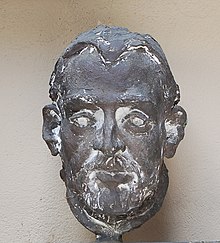Peter Faber
Pierre Favre (or Lefèvre ), Latinized Petrus Faber , Germanized Peter Faber , popularly also Father Faber (born April 13, 1506 in Le Villaret , Savoy ; † August 1, 1546 in Rome ), was one of the companions of Ignatius of Loyola a co-founder of the Jesuit order . He is venerated as a saint in the Catholic Church .
Life
Faber felt called to the priesthood at an early age and was able to begin studying at the Collège Sainte-Barbe in Paris in 1525, despite adverse financial circumstances . He shared his room with the hll. Ignatius and Franz Xavier .
In 1534 Petrus Faber was ordained a priest. In the same year he and the young community around Ignatius von Loyola took vows in Paris , which led to the foundation of the Jesuit order in 1540. In 1537 the group moved to Venice . In the following years Father Faber worked with companions in Parma and Ravenna .
In 1541 he took part in the Worms Religious Discussion (1541) and the Regensburg Religious Discussion (1541) . In 1542, after a short stay in Spain, he returned to Germany and worked in the dioceses of Speyer , Mainz and Cologne primarily as a spiritual master of exercises . During this activity he got to know the young Petrus Canisius in Mainz , who was strongly influenced by Faber's retreat in his future life planning and won over to the Jesuit order. He was to become an important person of the Counter Reformation , and later even a saint. In Germany, Petrus Faber observed that the immoral behavior in parts of the clergy and the lack of religious knowledge among the people were the main reasons for the success of Protestantism, which had far-reaching consequences for the apostolic orientation of the very young Jesuit order. At the various places where he worked, Faber maintained intensive spiritual contacts with the Carthusian monks , who helped to shape his spirituality. With their help, he also set up the first branch of the Jesuit order on German soil in Cologne. In Mainz he especially venerated the so-called cross of grace , which is now in the seminary there. He also mentioned it several times in his “Memoriale” , the spiritual diary, begun in 1542 .
In 1543 Peter Faber came to Leuven and Antwerp in Flanders . In 1544 he was sent to Portugal and Spain and from there called to Italy to take part in the Council of Trent as papal theologian . On July 17, 1546, he arrived in Rome, completely exhausted as a result of his incessant long journeys on foot. There he died, according to tradition, in the arms of Ignatius.
Beatification and Canonization
Petrus Faber was beatified on September 5th, 1872 , his feast day is August 1st . On December 17, 2013, Pope Francis canonized him by decree , waiving formal requirements and ceremonies .
Fonts
- Memorials. The spiritual diary of the first Jesuit in Germany. Translated from the manuscript and introduced by Peter Henrici . Johannes, Einsiedeln 1963; 2nd edition 1989.
literature
- Friedrich Wilhelm Bautz : Peter Faber. In: Biographisch-Bibliographisches Kirchenlexikon (BBKL). Volume 1, Bautz, Hamm 1975. 2nd, unchanged edition Hamm 1990, ISBN 3-88309-013-1 , Sp. 1585-1586.
- Rudolf Cornely : Life of the Blessed Petrus Faber, first priest of the Society of Jesus . Herder, Freiburg im Breisgau 2nd edition, improved and enlarged by Heinrich Scheid, 1900.
- Rita Haub : Peter Faber. Globetrotter of God . Lahn-Verlag, Kevelaer 2006, ISBN 3-7867-8568-6 .
- Severin Leitner : Peter Faber SJ (1506–1546). Spiritual form and spirituality . In: Spirit and Life . tape 79 , no. 2 , 2006, p. 89-106 ( echter.de ).
- Christoph Nebgen (Ed.): Time is a messenger from God. Saint Peter Faber SJ and his work in Mainz (= Mainzer Perspektiven: From the history of the diocese, vol. 7). Echter, Würzburg 2014, ISBN 978-3-429-03723-9 .
- Klaus Schatz : Germany and the Reformation from the perspective of Peter Faber (1506–1546) . In: Spirit and Life . tape 69 , 1996, pp. 259-272 ( echter.de ).
Individual evidence
- ^ Severin Leitner: Peter Faber SJ (1506–1546). Spiritual form and spirituality . In: Geist und Leben , Vol. 79 (2006), pp. 89–106, here p. 90.
- ^ Website of the diocese of Mainz on the Franziskuskapelle with the cross of grace
- ^ Severin Leitner: Peter Faber SJ (1506–1546). Spiritual form and spirituality . In: Geist und Leben , Vol. 79 (2006), pp. 89–106, here p. 96.
- ^ Catholic News Agency (KNA), December 18, 2013
Web links
- Literature by and about Peter Faber in the catalog of the German National Library
- Otto Syre SJ: Article about Petrus Faber in the SJ calendar
- Karl Cardinal Lehmann on Petrus Faber
| personal data | |
|---|---|
| SURNAME | Faber, Peter |
| BRIEF DESCRIPTION | Saint, companion of Ignatius of Loyola and co-founder of the Jesuits |
| DATE OF BIRTH | April 13, 1506 |
| PLACE OF BIRTH | Le Villaret , Savoy |
| DATE OF DEATH | August 1, 1546 |
| Place of death | Rome |

